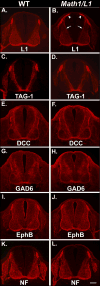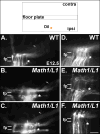Mis-expression of L1 on pre-crossing spinal commissural axons disrupts pathfinding at the ventral midline
- PMID: 17884558
- PMCID: PMC2111042
- DOI: 10.1016/j.mcn.2007.08.003
Mis-expression of L1 on pre-crossing spinal commissural axons disrupts pathfinding at the ventral midline
Abstract
In vertebrates, spinal commissural axons project along a transverse path toward and across the floor plate (FP). Post-crossing commissural axons alter their responsiveness to FP-associated guidance cues and turn to project longitudinally in a fasciculated manner prior to extending away from the midline. The upregulation of the neural cell adhesion molecule L1 on crossed commissural axon segments has been proposed to facilitate pathfinding on the contralateral side of the FP. To explore this possibility in vivo, we used Math1 regulatory sequences to target L1 to commissural axons before they cross the ventral midline. L1 mis-expression did not alter the distribution of commissural axon-associated markers or the ventral extension of commissural axons toward the midline. However, commissural axons often stalled or inappropriately projected into the longitudinal plane at the ipsilateral FP margin. These observations suggest that L1-mediated pathfinding decisions are normally delayed until axons have crossed the ventral midline (VM).
Figures









Similar articles
-
Manipulating Robo expression in vivo perturbs commissural axon pathfinding in the chick spinal cord.J Neurosci. 2008 Aug 27;28(35):8698-708. doi: 10.1523/JNEUROSCI.1479-08.2008. J Neurosci. 2008. PMID: 18753371 Free PMC article.
-
Ipsi- and contralateral commissural growth cones react differently to the cellular environment of the ventral zebrafish spinal cord.J Comp Neurol. 1994 Dec 1;350(1):122-32. doi: 10.1002/cne.903500109. J Comp Neurol. 1994. PMID: 7860796
-
Diversity of contralateral commissural projections in the embryonic rodent spinal cord.J Comp Neurol. 2004 May 10;472(4):411-22. doi: 10.1002/cne.20086. J Comp Neurol. 2004. PMID: 15065116
-
Axon guidance at the midline choice point.Dev Dyn. 2001 Jun;221(2):154-81. doi: 10.1002/dvdy.1143. Dev Dyn. 2001. PMID: 11376484 Review.
-
The role of the floor plate in axon guidance.Annu Rev Neurosci. 1995;18:497-529. doi: 10.1146/annurev.ne.18.030195.002433. Annu Rev Neurosci. 1995. PMID: 7605072 Review.
Cited by
-
The UNC5C netrin receptor regulates dorsal guidance of mouse hindbrain axons.J Neurosci. 2011 Feb 9;31(6):2167-79. doi: 10.1523/JNEUROSCI.5254-10.2011. J Neurosci. 2011. PMID: 21307253 Free PMC article.
-
Commissural axon navigation: Control of midline crossing in the vertebrate spinal cord by the semaphorin 3B signaling.Cell Adh Migr. 2016 Nov;10(6):604-617. doi: 10.1080/19336918.2016.1212804. Epub 2016 Aug 17. Cell Adh Migr. 2016. PMID: 27532244 Free PMC article. Review.
-
Type Ib BMP receptors mediate the rate of commissural axon extension through inhibition of cofilin activity.Development. 2013 Jan 15;140(2):333-42. doi: 10.1242/dev.089524. Development. 2013. PMID: 23250207 Free PMC article.
-
From classical to current: analyzing peripheral nervous system and spinal cord lineage and fate.Dev Biol. 2015 Feb 15;398(2):135-46. doi: 10.1016/j.ydbio.2014.09.033. Epub 2014 Oct 24. Dev Biol. 2015. PMID: 25446276 Free PMC article. Review.
-
Neuropilin2 regulates the guidance of post-crossing spinal commissural axons in a subtype-specific manner.Neural Dev. 2013 Jul 31;8:15. doi: 10.1186/1749-8104-8-15. Neural Dev. 2013. PMID: 23902858 Free PMC article.
References
-
- Bovolenta P, Dodd J. Guidance of commissural growth cones at the floor plate in embryonic rat spinal cord. Development. 1990;109:435–447. - PubMed
-
- Brittis PA, Lu Q, Flanagan JG. Axonal protein synthesis provides a mechanism for localized regulation at an intermediate target. Cell. 2002;110:223–235. - PubMed
-
- Brummendorf T, Kenwrick S, Rathjen FG. Neural cell recognition molecule L1: from cell biology to human hereditary brain malformations. Curr Opin Neurobiol. 1998;8:87–97. - PubMed
-
- Caspary T, Anderson KV. Patterning cell types in the dorsal spinal cord: what the mouse mutants say. Nat Rev Neurosci. 2003;4:289–297. - PubMed
Publication types
MeSH terms
Substances
Grants and funding
LinkOut - more resources
Full Text Sources
Molecular Biology Databases

